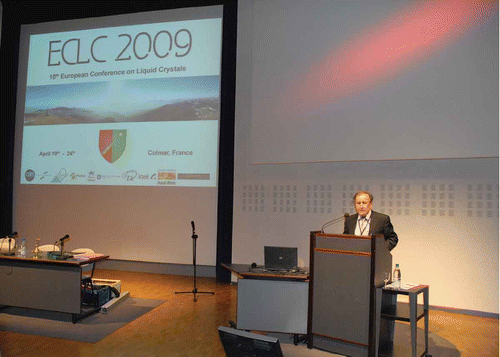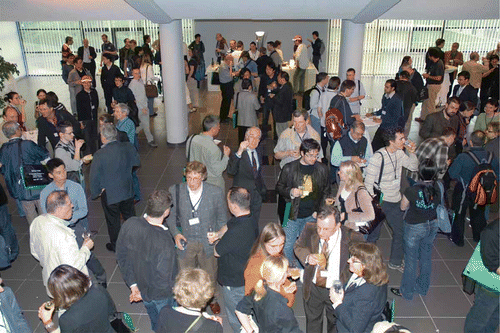10th European Conference on Liquid Crystals (ECLC 2009)
The 10th European Conference on Liquid Crystals (ECLC 2009) held in beautiful Colmar (France), located at the feet of the French Vosges mountains and the German Black Forest, from 19–24 April 2009 was organised by the Institut de Physique et Chimie des Matériaux de Strasbourg and the Institut Charles Sadron. The conference organising committee, chaired by Daniel Guillon (Strasbourg), arranged a multifaceted scientific program covering a wide range of topics in the realm of modern liquid crystal research.
A splendid collection of speakers and poster presenters shared the results of their research with the participating liquid crystal community in nine sessions ranging from more classical topics such as self-organisation, structure, polymers, elastomers, display application and physical properties to topics receiving increasing attention in recent years such as nanoparticle/liquid crystal hybrids, new materials, molecular electronics, biaxiality and biomaterials. Overall, participants of the conference witnessed 110 talks, among those 24 invited and six plenary lectures, as well as 223 poster presentations.
The opening lecture, given by P. Pieranski (Laboratoire de Physique des Solides, Orsay) on inverted cubic lyotropic crystals, was an excellent choice to set the tone for the conference. As an inspiring educator and lecturer on liquid crystal physics, Pieranski showed how earlier theories of de Gennes and the theories and experiments by Maxwell and Reynold that are over a century old can lend support to explain recent experimental results on shape changes of inverted cubic lyotropic crystals in temperature gradients. The opening lecture stood as an example of where liquid crystal research came from and where it is set to go, but also showed in an impressive fashion that an awareness of the historic aspects of liquid crystal research can provide insights into many current questions and pressing problems, now and in the future – an important take home message, I believe, particularly for the many younger conference participants.
The other plenary talks were given by Rudolf Zentel (Mainz), Ewa Gorecka (Warsaw), Françoise Livolant (Orsay), Mohammed Ibn-Elhay (Rolic Technologies, Ltd) and Martin Čopič (Ljubljana). Rudolf Zentel's talk was one of many contributions to one of the emerging hot topics of liquid crystal research, that of liquid crystal colloids and nanoparticle/liquid crystal hybrids. His group developed a methodology that allows for the preparation of anisotropic mesoscopic objects (i.e. anisotropic colloids) utilising either a dispersion polymerisation or a mini-emulsion polymerisation approach of acrylate monomers in water or dimethylsiloxane as solvents. The resulting colloids range in size from 0.6 to 3 μm for the dispersion polymerisation to as small as 100 nm for the mini-emulsion polymerisation. He also presented very recent results on the preparation of semiconducting, anisotropic inorganic nanoparticles with a polymer coating exhibiting lyotropic liquid crystal phase behaviour in highly concentrated solutions. Other talks in this fascinating area focused on mesogen covered gold nanoparticles that assemble into three-dimensional (3D) nanoparticle strings embedded in the surrounding nematic continuum (or matrix). Nanoparticle assembly or self-assembly were also demonstrated using defects in smectic liquid crystal films, and via the formation of nematic liquid crystalline phases of iron oxide nanoparticles decorated with dendronised pro-mesogenic ligands. A very similar approach was also successfully utilised for the preparation of chiral liquid crystal fullerenes (so-called fullerodendrimers).
Aside from the use of liquid crystal motifs to assemble nanoparticles, the effects of small colloidal particles, true nanoparticles (in the nanometre regime) and carbon nanotubes in nematic, smectic and nematic blue phases were described in another 25+ oral and poster contributions highlighting the increasing importance of this fairly young area of liquid crystal research. Many of these theoretical and experimental reports addressed the doping of nanomaterials into liquid crystal phases with the aim of modulating or improving the characteristics of the liquid crystals used in display applications; others were shining more light onto fundamental aspects such as thermal effects in nanoparticle-doped liquid crystals as well as effects of confinement and interactions between colloidal particles in complex nematic colloids.
Ewa Gorecka's plenary lecture focused on complex density-modulated structures for bent-core liquid crystals. Gorecka, using temperature-dependent small angle X-ray scattering on partially oriented samples of a bent-core liquid crystal material, showed that both the B1rev and the SmGC phase can either exist for the same material at different temperatures and even co-exist in a given temperature interval. Not surprisingly, theory, synthesis and characterisation of bent-core liquid crystals were again some of the dominating topics of the conference. Contributions in this area ranged from quadratic electroclinic effects, elastic and flexoelectric properties over self-assembled optical gratings to pyroelectric behaviour and biaxial nematic bent-core liquid crystals.
Liquid crystal research at the interface between physics and biology was appropriately opened by Françoise Livolant's plenary talk. Using cryo-electron microscopy, Livolant and co-workers were able to follow the organisation of DNA inside the capsid of tailed bacteriophages at different stages of the DNA ejection process. These studies showed quite remarkably that DNA chains always occupy the complete volume of the capsid, and also that the single DNA chain undergoes several phase transitions from constrained hexagonal to hexagonal to cholesteric and isotropic phases during this process, following the same sequence reported earlier for short, non-confined DNA fragments. A number of impressive reports followed describing liquid crystal phase formation and phase separation of ultra-short DNA oligomers (so-called nanoDNA), hexagonal columnar phases in dense states of rod-like viruses, lab-on-a-chip liquid crystal biosensors and inroads for the use of liquid crystals for biomedical optical imaging systems.
The conference also included several sessions on liquid crystal applications ranging from the use of discotic liquid crystals as organic semiconductors over polymer-liquid crystal diffractive and emissive devices to current trends in liquid crystal display technology including recycling of liquid crystals from display devices. Mohammed Ibn-Elhaj of Rolic Technology, Ltd in his plenary talk provided an overview over current industrial trends in optical film applications of liquid crystals with a particular emphasis on cost-effective industrial feasibility and technological advancements. With a view to potential applications, one session and a number of poster presentations also dealt with biaxial liquid crystal phases (both polar and non-polar). Other highlights in the application sessions were highly efficient transflective liquid crystal displays, lasing using liquid crystals, tuneable liquid crystal optical micro-resonators and photonic lattices in polymer-dispersed liquid crystals.
The sixth and final plenary lecture was held by Martin Čopič on nematic fluctuations and semi-soft elasticity in liquid crystal elastomers. Using light scattering, Čopič and co-workers were able to measure the relaxation rate of orientational fluctuations in nematic elastomers. The data collected with this technique showed that there is residual nematic order also in the isotropic phase and that the director becomes unstable at a critical strain in the geometry of the semi-soft elastic mode. In response to this strain, the director starts to rotate analogous to the electric or magnetic field induced Freedericksz effect.
The conference also saw a large number of excellent oral and poster contributions in the more classical disciplines dedicated to the investigation of physical properties of liquid crystals as well as the synthesis and characterisation of liquid crystals, with the latter showing an increasing number of more exotic molecular designs and concepts leading to complex, self-assembled liquid crystalline structures and phases.
I believe all applicants enjoyed an excellent and very diverse scientific program covering almost all aspects of liquid crystal research from very fundamental studies to future potential applications of liquid crystals in device technologies, bioscience and biology as well as in medical applications. All conference participants were spoiled not only by the beauty of Colmar as the location, but also by the culinary delights served during each lunch break. In addition, conference participants and accompanying persons could enjoy one or both of the organised excursions: a guided tour through the historical centre of Colmar and a wine tasting trip to Eguisheim, a medieval village fortified in 1257 and the birthplace of Pope Saint Leo IX, in the heart of the Alsace wine region. As a final highlight of the conference, participants also experienced a fantastic banquet at the castle of Kientzheim, near Kaysersberg, which started with yet another wonderfully celebrated wine tasting just before dinner.
Figure 3. The wine tasting and conference dinner were not the only social events which were enjoyed by the conference participants.

All in all, the Strasbourg group organised a fantastic 10th European Conference on Liquid Crystals, which will be remembered, as stated by Duncan Bruce in his closing remarks, as a conference with ‘a high standard’, a ‘bright and warm atmosphere set by the people’ and ‘an overall fantastic choice’ for this meeting.
The next 11th European Conference on Liquid Crystals will be held in Maribor (Slovenia) in 2011. I believe the organising committee of this past conference in Colmar has truly set the bar high. Congratulations!

